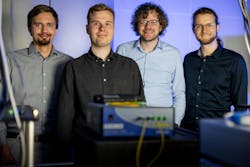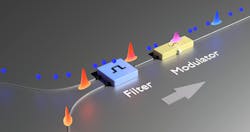A team of four physicists at the Institute of Photonics at Leibniz University Hannover in Germany recently came up with a potential solution to combine the conventional internet with the quantum internet—enabling two different types of light to coexist on the same frequency channel (see video).
In an experiment, they proved photonic entanglement is maintained even when the photons are sent together with a laser pulse. It allows them to change the color of the laser pulse with a high-speed electrical signal to match the color of the entangled photons. This means they can combine and separate laser pulses and entangled photons of the same color within an optical fiber.
“Our work was driven by the need to integrate quantum communications into existing fiber-optic networks,” says Michael Kues, head of the Institute of Photonics at Leibniz University Hannover. “The challenge of combining quantum and classical data transmission on the same fiber sparked our interest—particularly in advancing the development of a secure quantum internet.”
Serrodyne shifting technique
The core concept behind the team’s work is the serrodyne shifting technique, which involves using a linear temporal phase ramp to translate the spectrum of an optical pulse. This allows the color of the laser pulse to be changed by modifying its temporal phase.
“It basically adds energy to the light, or removes energy, which changes its color,” explains Kues. “It’s important that laser pulses and electronic pulses (used for the phase manipulation) arrive simultaneously. For the rest of the time, the electronic signal is off, so entangled photons are transmitted unperturbed. It allows these different types of light to coexist on the same frequency channel—which enables efficient use of bandwidth.”
For their design work, the team combined a complex interplay of quantum photonics and microwave technology, which provided them with completely new insights and challenges that needed to be understood.
“As an example, we require precise control of the interaction between the electronic signal and the laser pulses, which we achieve by controlling their arrival time,” Kues says. “Great care went into minimizing drifts in the arrival time difference between the two signals. To do this, we used a stabilized mode-locked laser and a sophisticated multichannel electronic signal generator for the multi-gigahertz regime.”
A large challenge for the team was to minimize the optical loss within the transceiver, because too much loss would make the reconstruction of the quantum state challenging. “In the future, we see great potential in integrating the fiber-coupled transceiver components into a single photonic integrated circuit to minimize the loss and enable greater performance of the frequency shift,” Kues says.
Two of the most exciting moments for the team involved shifting the frequency of the laser pulses, and the cancellation after turning on the inverse signal on the second phase modulator.
“The cancellation of the frequency shift is remarkably good,” says Philip Rübeling, who is pursuing a Ph.D. at the Institute of Photonics. “And the second moment was seeing the effect on the quantum signal. Demonstrating that entangled photons can be transmitted by the serrodyne transceiver on the same frequency channel as classical laser light and separated again without losing their quantum properties is a great result for this work.”
Before now, it wasn’t possible to use both transmission methods per color within an optical fiber because the “entangled photons block a data channel in the optical fiber, which prevents its use for conventional data transmission,” says Jan Heine, a doctoral student working with Kues.
The experiment showed that photons can be sent within the same color channel as the laser light, which suggests that all color channels can still be used for conventional data transmission—and a mixed or hybrid quantum and conventional network can succeed.
This work paves the way for the next generation of telecommunications, including quantum key distribution over existing fiber networks. “It could lead to the development of a secure quantum internet and enhance data security for critical infrastructure,” says Kues. “We also contributed to the understanding of electro-optic manipulation of quantum light by discovering and investigating the different serrodyne dynamics for frequency-entangled photons.”
The next steps will involve “demonstrating the serrodyne transceiver concept within a deployed fiber link, which works in a truly hybrid way, to transmit entangled photons and classical data at the same time,” says Kues.
FURTHER READING
P. Rübeling, J. Heine, R. Johanning, and M. Kues, Sci. Adv., 10, eadn8907 (2024); https://doi.org/10.1126/sciadv.adn8907.
About the Author
Sally Cole Johnson
Editor in Chief
Sally Cole Johnson, Laser Focus World’s editor in chief, is a science and technology journalist who specializes in physics and semiconductors.


